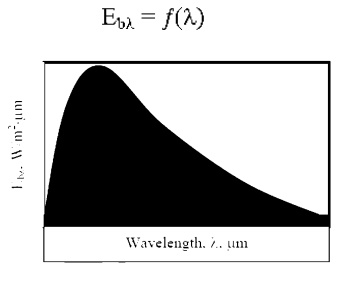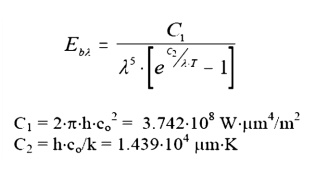Chapter: Mechanical : Heat and Mass Transfer : Radiation
Plank’s Law
Plank’s Law
While the Stefan-Boltzman law is useful for studying overall energy emissions, it does not allow us to treat those interactions, which deal specifically with wavelength, overcome by another of the modern physicists, Max Plank, who developed a relationship for wave-based emissions.

We haven’t yet defined the bλ.MonochromaticAnimplicitdefinitionis Emi
provided by the following equation:

We may view this equation graphically as follows:

A definition of monochromatic Emissive Power would be obtained by differentiating the integral equation:

The actual form of Plank’s law is:

Where: h, co, k are all parameters from quantum physics. We need not worry about their precise definition here.
This equation may be solved at any T, λ to give the value of the monochromatic emissivity at that
that condition. Alternatively, the function may be substituted into the integral

to find the Emissive power for any temperature. While performing this integral by hand is difficult, students may readily evaluate the integral through one of several computer programs, i.e. MathCad, Maple, Mathmatica, etc.

Emission Over Specific Wave Length Bands
Consider the problem of designing a tanning machine. As a part of the machine, we will need to design a very powerful incandescent light source. We may wish to know how much energy is being emitted over the
ultraviolet band (10-4 to 0.4 μm), known to be particularly dangerous.

With a computer available, evaluation of this integral is rather trivial. Alternatively, the text books provide a table of integrals. The format used is as follows:

Referring to such tables, we see the last two functions listed in the second column. In the first column is a⋅T. Thisparameter,isfoundbytakingthe productλ of the absolute temperature of
the emitting surface, T, and the upper limit incandescent bulb is designed to operate at a temperature of 2000K. Reading from the table:
λ.,

This is the fraction of the total energy emitted which falls within the IR band. To find the absolute energy emitted multiply this value times the total energy emitted:

Related Topics